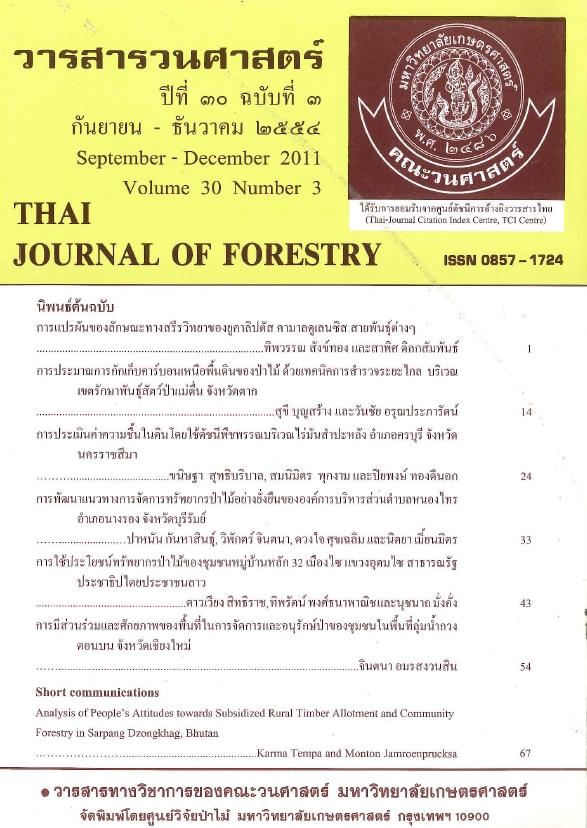การมีส่วนร่วมและศักยภาพของพื้นที่ในการจัดการและอนุรักษ์ป่าของชุมชน ในพื้นที่ลุ่มน้ำกวงตอนบน จังหวัดเชียงใหม่
Main Article Content
บทคัดย่อ
การศึกษานี้มีวัตถุประสงค์เพื่อศึกษาศักยภาพของพื้นที่และการมีส่วนร่วมของชุมชนในการจัดการและอนุรักษ์ป่าไม้ในพื้นที่ลุ่มน้ำกวงตอนบน อำเภอดอยสะเก็ด และอำเภอแม่ออน จังหวัดเชียงใหม่ ประกอบด้วย การศึกษาการมีส่วนร่วมของชุมชนในการจัดการและอนุรักษ์ป่าไม้ การศึกษาศักยภาพของพื้นที่ในการจัดการและอนุรักษ์ป่าไม้ของชุมชน และการศึกษาความสอดคล้องของการมีส่วนร่วมของชุมชนกับพื้นที่ที่มีศักยภาพในการจัดการและอนุรักษ์ป่าไม้ เก็บรวบรวมข้อมูลด้านสังคม โดยใช้แบบสัมภาษณ์แบบมีโครงสร้าง สุ่มตัวอย่างจำนวน 360 ครัวเรือน 23 หมู่บ้าน และวิเคราะห์ข้อมูลด้วยโปรแกรมสำเร็จรูป SPSS เวอร์ชัน 11 โดยใช้สถิติร้อยละ ค่าเฉลี่ย ส่วนเบี่ยงเบนมาตรฐาน และทดสอบสมมติฐานโดยใช้ pearson correlation และ t-test ส่วนศักยภาพของพื้นที่ใช้ระบบสารสนเทศภูมิศาสตร์ประเมินความเหมาะสมในการเข้าไปใช้ประโยชน์ จัดการและอนุรักษ์ป่าไม้ โดยกำหนดปัจจัยด้านกายภาพจำนวน 7 ปัจจัย ได้แก่ ระยะห่างจากหมู่บ้าน ระยะห่างจากถนน ประเภทการใช้ประโยชน์ที่ดิน ระดับความลาดชัน มวลชีวภาพป่าไม้ ชั้นคุณภาพลุ่มน้ำ และ เขตการใช้ที่ดินป่าไม้ ทำการกำหนดค่าถ่วงน้ำหนักปัจจัยและคะแนนช่วงของปัจจัยโดยใช้วิธีแต่งตั้งผู้เชี่ยวชาญ นำค่าเฉลี่ยค่าถ่วงน้ำหนักปัจจัยและค่าเฉลี่ยคะแนนช่วงของปัจจัยดังกล่าวไปใช้ในสมการกำหนดค่าถ่วงน้ำหนักปัจจัย ดำเนินการซ้อนทับข้อมูล (overlay) ปัจจัยทางกายภาพทั้งหมดด้วยสมการข้างต้น ทำการจัดกลุ่มระดับศักยภาพพื้นที่โดยใช้วิธี Jenks natural breaks classification และใช้ mann-whitney U test ในการทดสอบความสอดคล้องของศักยภาพพื้นที่กับระดับการมีส่วนร่วม
ผลการศึกษาพบว่า ชุมชนในพื้นที่ลุ่มน้ำกวงตอนบนมีส่วนร่วมในการจัดการและอนุรักษ์ป่าไม้อยู่ในระดับมาก และปัจจัยที่ส่งผลต่อการมีส่วนร่วมของชุมชนในการจัดการและอนุรักษ์ป่าอย่างมีนัยสำคัญทางสถิติ ได้แก่ ความเข้มแข็งของชุมชน ผลประโยชน์จากป่าที่ได้รับจากการมีส่วนร่วมในการจัดการและอนุรักษ์ป่าไม้ ความรู้ความเข้าใจเกี่ยวกับกฎหมายป่าไม้ บทบาทของผู้นำชุมชนในการจัดการและอนุรักษ์ป่าไม้และการได้รับการสนับสนุนจากภายนอก ส่วนศักยภาพของพื้นที่พบว่าพื้นที่ลุ่มน้ำแม่กวงตอนบนส่วนใหญ่มีศักยภาพในการจัดการและอนุรักษ์อยู่ในระดับค่อนข้างมาก (ร้อยละ 31.41) โดยส่วนใหญ่จะอยู่ใกล้หมู่บ้าน และผลการศึกษาความสอดคล้องของการมีส่วนร่วมของชุมชนในการจัดการและอนุรักษ์ป่ากับศักยภาพของพื้นที่ พบว่า มีความสอดคล้องกัน กล่าวคือ พื้นที่มีระดับศักยภาพมากจะมีระดับการมีส่วนร่วมมาก ส่วนพื้นที่มีระดับศักยภาพน้อยจะมีระดับการมีส่วนร่วมน้อย จากจำนวนหมู่บ้านทั้งหมด 23 หมู่บ้านในพื้นที่ลุ่มน้ำแม่กวงตอนบน ระดับการมีส่วนร่วมมากและระดับศักยภาพพื้นที่อยู่ในระดับมากมีจำนวน 15 หมู่บ้าน ระดับการมีส่วนร่วมน้อยแต่ระดับศักยภาพพื้นที่อยู่ในระดับค่อนข้างมาก จำนวน 3 หมู่บ้าน และมีจำนวน 5 หมู่บ้านที่มีความไม่สอดคล้องกันระหว่างระดับการมีส่วนร่วมกับระดับศักยภาพพื้นที่
คำสำคัญ: การมีส่วนร่วม การอนุรักษ์ป่าโดยชุมชน ศักยภาพของพื้นที่เพื่อการอนุรักษ์ ระบบสารสนเทศภูมิศาสตร์
Downloads
Article Details

อนุญาตภายใต้เงื่อนไข Creative Commons Attribution-NonCommercial-NoDerivatives 4.0 International License.
ข้าพเจ้าและผู้เขียนร่วม (ถ้ามี) ขอรับรองว่า ต้นฉบับที่เสนอมานี้ยังไม่เคยได้รับการตีพิมพ์และไม่ได้อยู่ในระหว่างกระบวนการพิจารณาตีพิมพ์ลงในวารสารหรือสิ่งตีพิมพ์อื่นใด ข้าพเจ้าและผู้เขียนร่วม (ถ้ามี) ยอมรับหลักเกณฑ์และเงื่อนไขการพิจารณาต้นฉบับ ทั้งยินยอมให้กองบรรณาธิการมีสิทธิ์พิจารณาและตรวจแก้ต้นฉบับได้ตามที่เห็นสมควร พร้อมนี้ขอมอบลิขสิทธิ์ผลงานที่ได้รับการตีพิมพ์ให้แก่วารสารวนศาสตร์ คณะวนศาสตร์ มหาวิทยาลัยเกษตรศาสตร์ กรณีมีการฟ้องร้องเรื่องการละเมิดลิขสิทธิ์เกี่ยวกับภาพ กราฟ ข้อความส่วนใดส่วนหนึ่ง หรือ ข้อคิดเห็นที่ปรากฏในผลงาน ให้เป็นความรับผิดชอบของข้าพเจ้าและผู้เขียนร่วม (ถ้ามี) แต่เพียงฝ่ายเดียว และหากข้าพเจ้าและผู้เขียนร่วม (ถ้ามี) ประสงค์ถอนบทความในระหว่างกระบวนการพิจารณาของทางวารสาร ข้าพเจ้าและผู้เขียนร่วม (ถ้ามี) ยินดีรับผิดชอบค่าใช้จ่ายทั้งหมดที่เกิดขึ้นในกระบวนการพิจารณาบทความนั้น”


